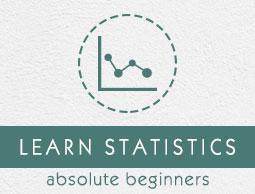Statistics - Notations
Following table shows the usage of various symbols used in Statistics
Capitalization
Generally lower case letters represent the sample attributes and capital case letters are used to represent population attributes.
$ P $ - population proportion.
$ p $ - sample proportion.
$ X $ - set of population elements.
$ x $ - set of sample elements.
$ N $ - set of population size.
$ N $ - set of sample size.
Greek Vs Roman letters
Roman letters represent the sample attributs and greek letters are used to represent Population attributes.
$ \mu $ - population mean.
$ \bar x $ - sample mean.
$ \delta $ - standard deviation of a population.
$ s $ - standard deviation of a sample.
Population specific Parameters
Following symbols represent population specific attributes.
$ \mu $ - population mean.
$ \delta $ - standard deviation of a population.
$ {\mu}^2 $ - variance of a population.
$ P $ - proportion of population elements having a particular attribute.
$ Q $ - proportion of population elements having no particular attribute.
$ \rho $ - population correlation coefficient based on all of the elements from a population.
$ N $ - number of elements in a population.
Sample specific Parameters
Following symbols represent population specific attributes.
$ \bar x $ - sample mean.
$ s $ - standard deviation of a sample.
$ {s}^2 $ - variance of a sample.
$ p $ - proportion of sample elements having a particular attribute.
$ q $ - proportion of sample elements having no particular attribute.
$ r $ - population correlation coefficient based on all of the elements from a sample.
$ n $ - number of elements in a sample.
Linear Regression
$ B_0 $ - intercept constant in a population regression line.
$ B_1 $ - regression coefficient in a population regression line.
$ {R}^2 $ - coefficient of determination.
$ b_0 $ - intercept constant in a sample regression line.
$ b_1 $ - regression coefficient in a sample regression line.
$ ^{s}b_1 $ - standard error of the slope of a regression line.
Probability
$ P(A) $ - probability that event A will occur.
$ P(A|B) $ - conditional probability that event A occurs, given that event B has occurred.
$ P(A') $ - probability of the complement of event A.
$ P(A \cap B) $ - probability of the intersection of events A and B.
$ P(A \cup B) $ - probability of the union of events A and B.
$ E(X) $ - expected value of random variable X.
$ b(x; n, P) $ - binomial probability.
$ b*(x; n, P) $ - negative binomial probability.
$ g(x; P) $ - geometric probability.
$ h(x; N, n, k) $ - hypergeometric probability.
Permutation/Combination
$ n! $ - factorial value of n.
$ ^{n}P_r $ - number of permutations of n things taken r at a time.
$ ^{n}C_r $ - number of combinations of n things taken r at a time.
Set
$ A \Cap B $ - intersection of set A and B.
$ A \Cup B $ - union of set A and B.
$ \{ A, B, C \} $ - set of elements consisting of A, B, and C.
$ \emptyset $ - null or empty set.
Hypothesis Testing
$ H_0 $ - null hypothesis.
$ H_1 $ - alternative hypothesis.
$ \alpha $ - significance level.
$ \beta $ - probability of committing a Type II error.
Random Variables
$ Z $ or $ z $ - standardized score, also known as a z score.
$ z_{\alpha} $ - standardized score that has a cumulative probability equal to $ 1 - \alpha $.
$ t_{\alpha} $ - t statistic that has a cumulative probability equal to $ 1 - \alpha $.
$ f_{\alpha} $ - f statistic that has a cumulative probability equal to $ 1 - \alpha $.
$ f_{\alpha}(v_1, v_2) $ - f statistic that has a cumulative probability equal to $ 1 - \alpha $ and $ v_1 $ and $ v_2 $ degrees of freedom.
$ X^2 $ - chi-square statistic.
Summation Symbols
$ \sum $ - summation symbol, used to compute sums over a range of values.
$ \sum x $ or $ \sum x_i $ - sum of a set of n observations. Thus, $ \sum x = x_1 + x_2 + ... + x_n $.


